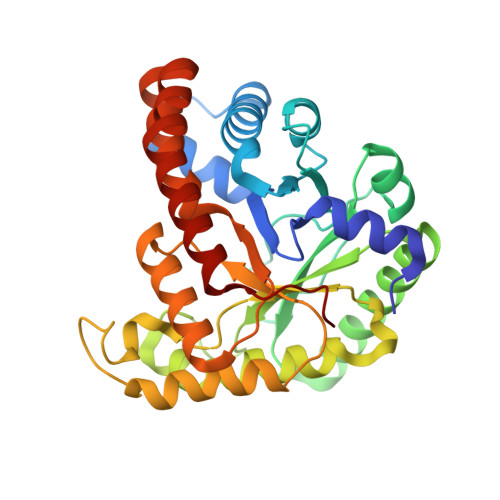Structure of a class I tagatose-1,6-bisphosphate aldolase: investigation into an apparent loss of stereospecificity.
LowKam, C., Liotard, B., Sygusch, J.(2010) J Biol Chem 285: 21143-21152
- PubMed: 20427286
- DOI: https://doi.org/10.1074/jbc.M109.080358
- Primary Citation of Related Structures:
3MHF, 3MHG - PubMed Abstract:
Tagatose-1,6-bisphosphate aldolase from Streptococcus pyogenes is a class I aldolase that exhibits a remarkable lack of chiral discrimination with respect to the configuration of hydroxyl groups at both C3 and C4 positions. The enzyme catalyzes the reversible cleavage of four diastereoisomers (fructose 1,6-bisphosphate (FBP), psicose 1,6-bisphosphate, sorbose 1,6-bisphosphate, and tagatose 1,6-bisphosphate) to dihydroxyacetone phosphate (DHAP) and d-glyceraldehyde 3-phosphate with high catalytic efficiency. To investigate its enzymatic mechanism, high resolution crystal structures were determined of both native enzyme and native enzyme in complex with dihydroxyacetone-P. The electron density map revealed a (alpha/beta)(8) fold in each dimeric subunit. Flash-cooled crystals of native enzyme soaked with dihydroxyacetone phosphate trapped a covalent intermediate with carbanionic character at Lys(205), different from the enamine mesomer bound in stereospecific class I FBP aldolase. Structural analysis indicates extensive active site conservation with respect to class I FBP aldolases, including conserved conformational responses to DHAP binding and conserved stereospecific proton transfer at the DHAP C3 carbon mediated by a proximal water molecule. Exchange reactions with tritiated water and tritium-labeled DHAP at C3 hydrogen were carried out in both solution and crystalline state to assess stereochemical control at C3. The kinetic studies show labeling at both pro-R and pro-S C3 positions of DHAP yet detritiation only at the C3 pro-S-labeled position. Detritiation of the C3 pro-R label was not detected and is consistent with preferential cis-trans isomerism about the C2-C3 bond in the carbanion as the mechanism responsible for C3 epimerization in tagatose-1,6-bisphosphate aldolase.
Organizational Affiliation:
Department of Biochemistry, Université de Montréal, Montréal, Québec H3C 3J7, Canada.
















